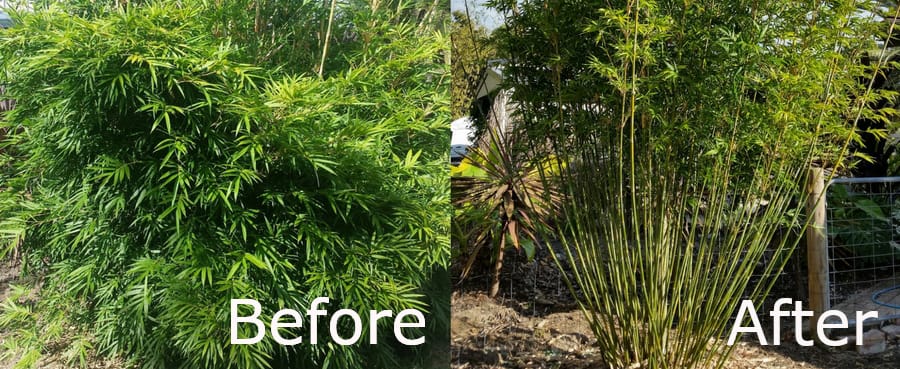Bamboo Maintenance
Late winter and early Spring are the best times of year to prune and clean out your bamboo clump. Pruning new culms and laterals in the grow season is not recommended - partly because it can be very warm here in Australia, but mostly because new growth culms have not hardened off and will die back, regardless of pruning height. In winter, the stems produced in autumn have become hardened and so it’s less likely the stem will fall back when cut to height. The new shoots typically won’t have emerged from the ground just yet.
How to prune your bamboo plant
So it’s an opportune time to prune your bamboo. But what's next? Firstly, think carefully about your target height as overtrimming will take time to recover foliage density at height.
Then it's time to cut the plant at your target height, which you may do in sections if the plant is particularly tall. We recommend choosing a spot just above a node (~2-3cm) for your final cut. The nodes are the “lumpy” nodules from which laterals (i.e. branched foliage) and each new section of culm begins to grow.When pruning the stem will die down to the cut point, so if you cut it consistently above the node you can achieve a more pleasant looking plant.
Tools and Equipment
For smaller, more delicate varieties, you will only require a pair of secateurs and/or loppers to maintain the clump. More advanced or mature plants will require loppers (ratchet type is effective) or a handheld reciprocating saw for thicker stems (7-10cm). Electric pruning shears are also an excellent option for clump pruning and further volume reduction of the cut mass.
For thinning the clump, select the older stems and remove them at the ground level, or just below the soil surface. These will be the smaller, thinner stems that live closest to the centre, that are fully set with their foliage. It may be necessary to cut a path into that area of the clump to gain access to them - again this can be done with a combination of secateurs, loppers and reciprocating saw.
To access bamboo at height, you will need to carefully plan your working area. Working in pairs is recommended. A platform ladder is likely required, ensuring that it is safely secured and stable before working at height. For larger jobs and commercial sites, a mobile lift platform may be considered. Please ensure you understand the risks of working at height, implementing any mitigation steps before commencing the job. Generally it is not necessary to reach the height of the target cut point itself - working in pairs, one person can work at height and pull down the culm while the other can retrieve and cut. Working in this way, it may only be necessary to work at half of the target height cut point, depending on thickness of culms and their respective flexibility.
It is best to provide clean cuts on your bamboo, hence the use of mini chain saws and hedgers is not recommended. The exception might be hedging species, such as Chinese Dwarf or Malay Dwarf Variegated.
Alternatively, one can also consider telescopic loppers to avoid working at heights. The blades need to be kept sharp on these tools and typically these can only be used for small to mid size varieties (with culms <5cm thick) and not giant bamboo species.
Stimulating bushy growth
If you want a less “open” look, then only cut the upper parts of each stem that is leaning out or above your desired target height. Pruning at select, variable heights is also a way to stimulate more bushy "undergrowth", especially for those species that more naturally tend to grow foliage from 1.5m-2m above ground. To do this, pick a select number of culms within the clump, perhaps a quarter or a third of the culms within the clump. Trim these, for example, at 2m, 3m and 4m, leaving the tallest culms untouched below your target height (e.g. 6m). With adequate light and nutrient, you should observe new “buds” developing at the lower nodes on these pruned culms. Following this pruning procedure will help create a more dense foliage screen, without reducing the overall height.
Fertilise in spring
Spring is also the best time to fertilise. There are many good products on the market. Always look for something that is properly formulated and is high in the N (Nitrogen) element — at least 10% or more.
Apply the fertiliser under the mulch, then water it thoroughly. The foliage that has been removed during the pruning process can be cut further and arranged at the base of the clump to be used as mulch if desired.
Be Patient
After pruning, you may lose some initial screening, especially if you have been a little over zealous, which tends to happen when you’re in the thick of it. Fear not though, as soon as new laterals develop and new foliage emerges you will have a dense screen once more.
Back to articles




